Finding Flavor and Diversity While Staying Close to Home
Written by Virginia Bolshakova
Firefly Fields Bouquet of Varietal Honey from Nashville, Michigan. Unique flavors and diversity from one farm across one season (2019).
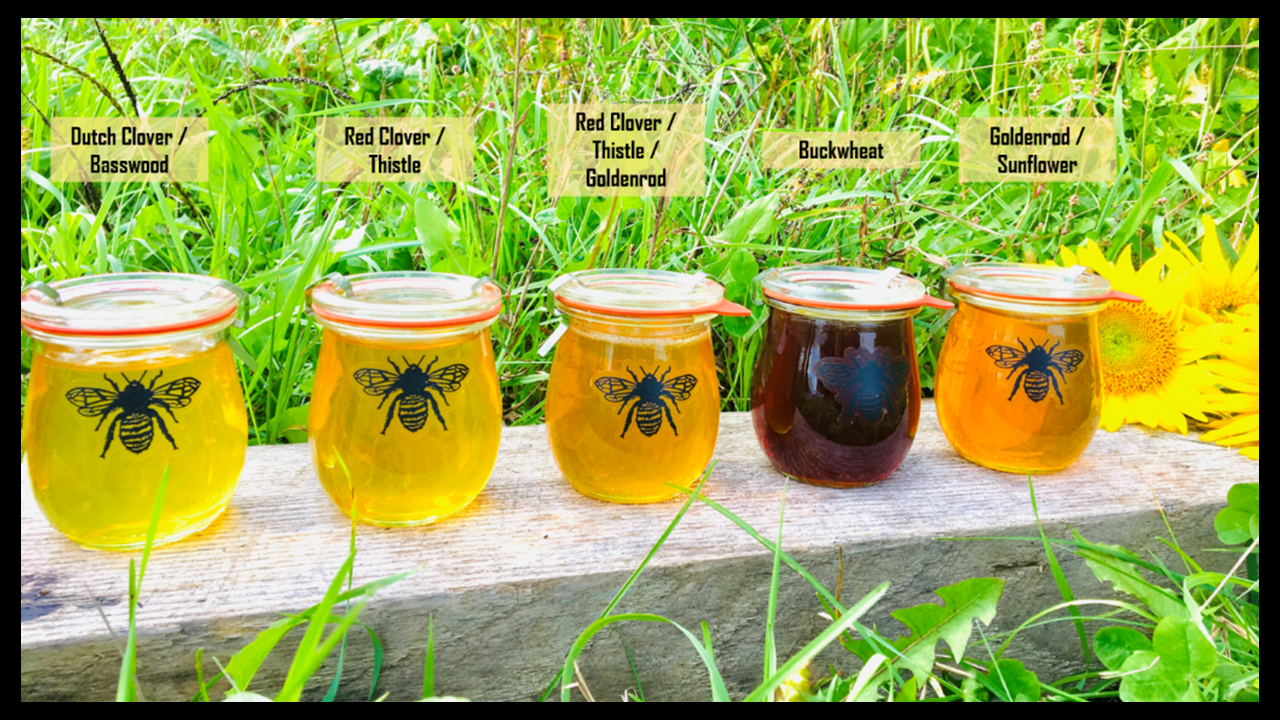
Capturing A Moment’s Flavor
When we bottle a jar of honey, it captures a very specific moment and flavor in time that details what was blooming on and around the farm. Beyond just the plants, the flavor characteristics can also tell us about the soil quality, microclimate, water, sun, and seasonal profile – all bottled up into our farm’s unique terroir.
Speaking of seasonal profiles, just as 2020 sinks more deeply into our daily lives, impacting and challenging what was once routine practice, we may find ourselves becoming experts in the art of reflection and adaptation. As a scientist, farmer, and beekeeper, it is important each year to observe, document, and learn from what the landscape, the bees, and the honey tell us. In 2019, our family farm like many across the Midwest of North America, experienced an agricultural crisis of its own from exceptional amounts of precipitation during critical times leading up to and through planting season keeping most farmers out of the field.
Precipitation for 2019 compared to 30-year average recorded at NOAA weather station near farm. The rains at critical times leading up to and through planting season kept farmers out of the field.
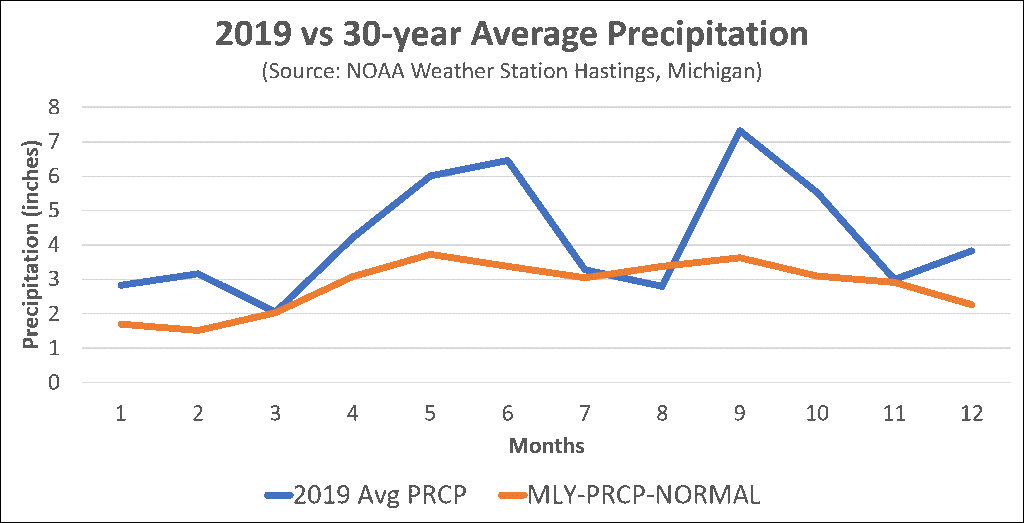
For the first time in 40 years, our family was unable to plant soybeans or corn. However, all was not lost. Firefly Fields is a three generation, USDA Certified Organic and Bee Friendly Certified farm established by my parents, Archie and Mattie Jennings in 1979. With much grit, love, and common sense, our farm has evolved to grow and harvest a diversity of delicious, wholesome specialty and organic foods on the farm’s 450 acres in southwestern Michigan. We grow and market a variety of raw honeys, organic beef, organic beans and grains (e.g. buckwheat, spelt, maize, soft red wheat, black beans, soybeans, etc.), and freshly milled flour from our 110-year-old French Burr Stone. Diversity and redundancy are key to our agroecological system, especially in times of crisis.
As Alexander Graham Bell once said, ‘When one door closes another one opens; but we often look so long and so regretfully upon the closed door that we do not see the ones which open for us.’ Without soybeans and corn in the field more attention was placed on things we could manage - our cover crop mixes and varietal honeys. Nectar resources were plentiful throughout 2019. As the cold and wet conditions early on kept us from planting crops in the spring, cover crops were planted in even more abundance and the late season honey flows were spectacular.
Cover cropping is important to regenerative ag systems. With extreme precipitation (in 2019), typical row crops were replaced entirely with cover crops of buckwheat, sunflowers, and red clover.
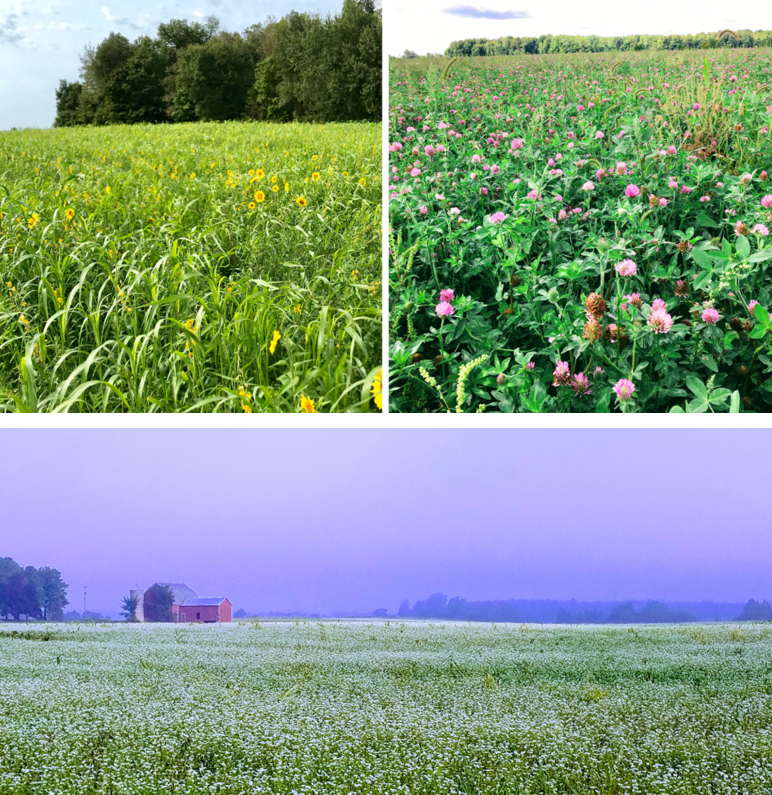
Around the time the first honey supers were added to the colonies in June, basswood from our woodlands and white Dutch clover across pastures were blooming across wide swaths. By early July, a thick carpet of a red clover cover crop covering more than 150 acres started blooming and stayed in bloom through mid-August. In addition, significant patches of Canada and Bull Thistle persisted across multiple areas of our organic farm from mid-July through August. By mid-August goldenrod started to bloom and continued to bloom for another month. For nearly the entire month of September, bees (and not just honey bees) and other pollinators had access to over 100 acres of sunflowers and 100+ acres of buckwheat. Within 24-hours of setting up three hives on a buckwheat cover crop, a conveyor belt of bees took flight from the bee yard to the buckwheat blooms bringing back the warm malty, mocha scent of their forage. It was DELIGHTFUL!!
Apiary Views, September 2019: Colonies strategically placed near buckwheat, sunflowers, and clover blooms. Weedy edges of goldenrod bloom abundantly throughout late summer across the farm.
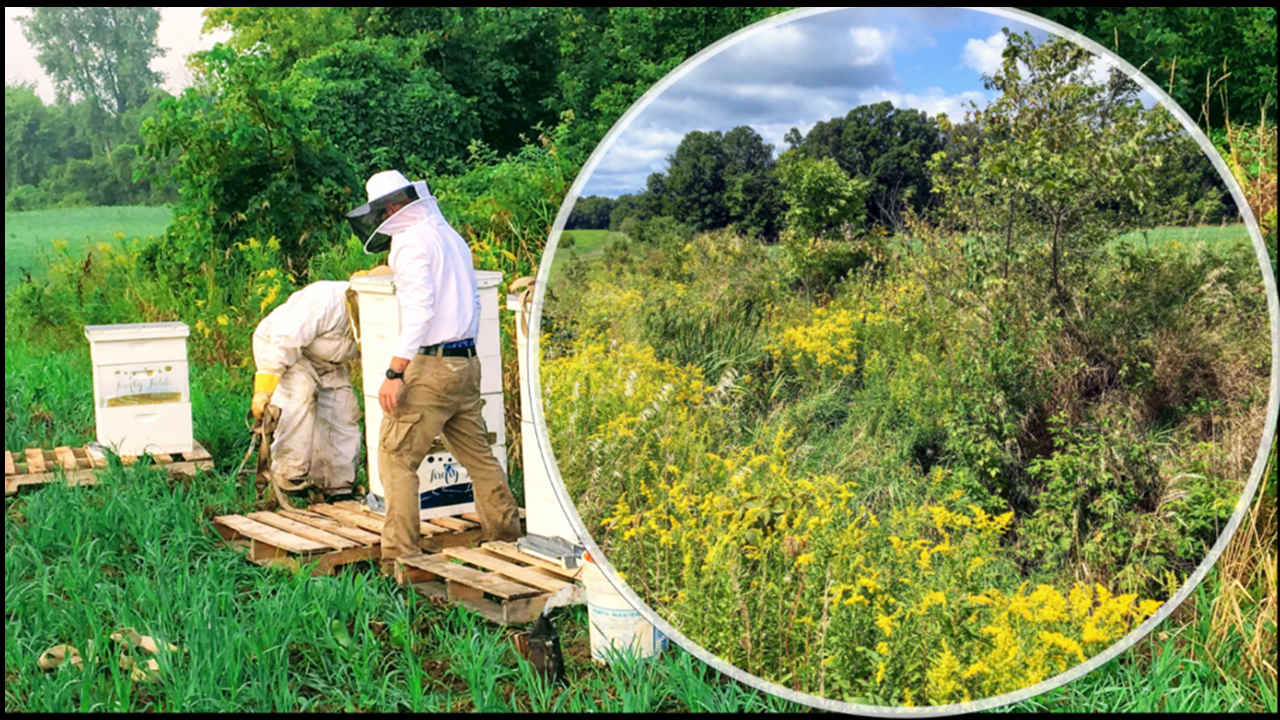
Of course, just because honey plants are available does not guarantee the bees are active and are foraging. Honey bee foraging habits are governed, in part, by flower constancy and accessibility, so if there are large clusters of similar flowers in bloom and the weather cooperates, the chance of a honey harvest is good. To confirm this, one must monitor flight and foraging behavior. Throughout 2019, as much as we visited the bee yard we hiked the fields to track honey bee activity on flowering plants that were nearby and in abundance. Blooming honey plants we followed were never more than 450 yards away from the hive.
Scouting honey bee foraging behavior includes monitoring flight direction as well as field verification of bees nectaring on blooms. Blooming flowers do not always mean a nectar flow into the hive.
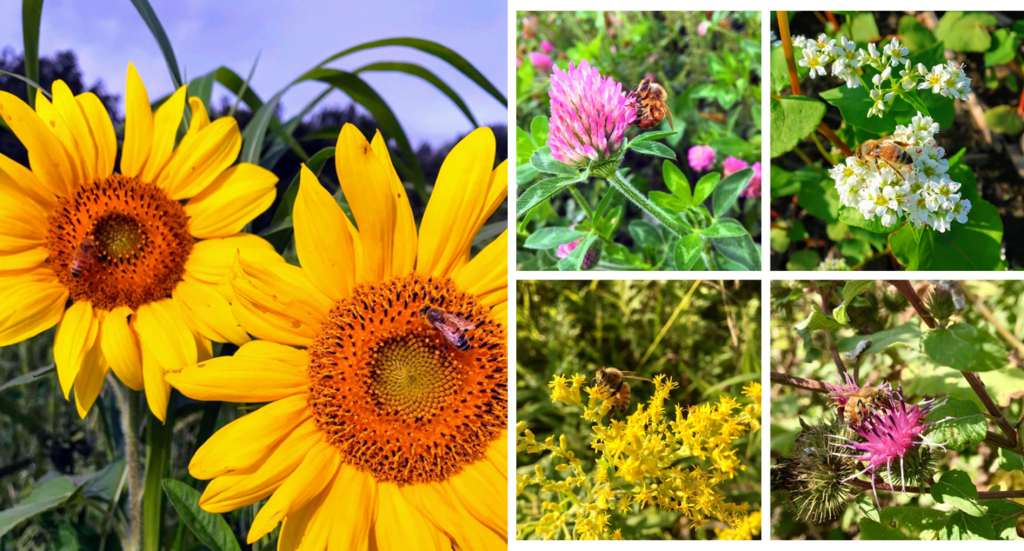
Collecting Honey Varietals
From the Honey Harvest graph, you can see the breakdown of each Likely Varietal Honey (e.g. Goldenrod + Sunflower, etc.) we extracted and how many gallons of each variety harvested. The Red Clover and Thistle Blend honey was the most abundant honey collected. It’s important to note that the honey we call ‘Mix Flower’ was also likely dominated by Red Clover and Thistle. Why? The bloom period for red clover and thistle is relatively long, spanning well over a month with individual plants blooming at different times across that period. In addition, the hives were at peak population during this time. Having the colony peak just before honey flow means they have the largest possible adult population able to take advantage of the flow with many forager bees able to bring nectar back to the hive.
Mid-point dates of forage and honey plants available to bees, and how many gallons of capped honey were produced during that period on six hives. The sum is just over 37 gallons, or roughly 440 lbs!
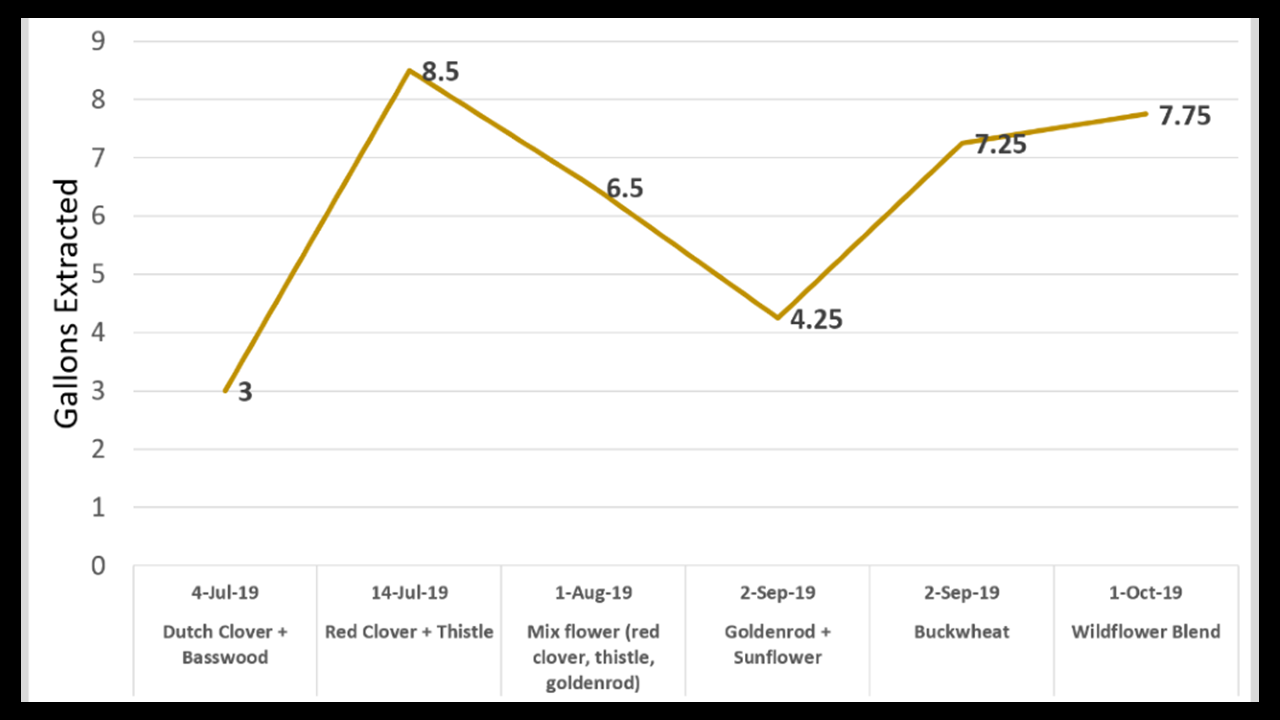
When the times are tough, there is always something to be learned. The 2019 honey crop demonstrated to us there is a real possibility of varietal honey that is all place-based at the farm. The ability to collect varietal honey from a single, diverse farm landscape means that the bees are kept happy throughout the year with multiple floral resources. When the land is managed well, we can find much flavor and diversity while staying close to home. Here is to discovering the richness and joy in life, while ‘keeping one foot in the furrow.’
Firefly Fields Flight of Raw Honey (2019); a display of floral and nectar diversity found across the landscape of one organic farm in Michigan.
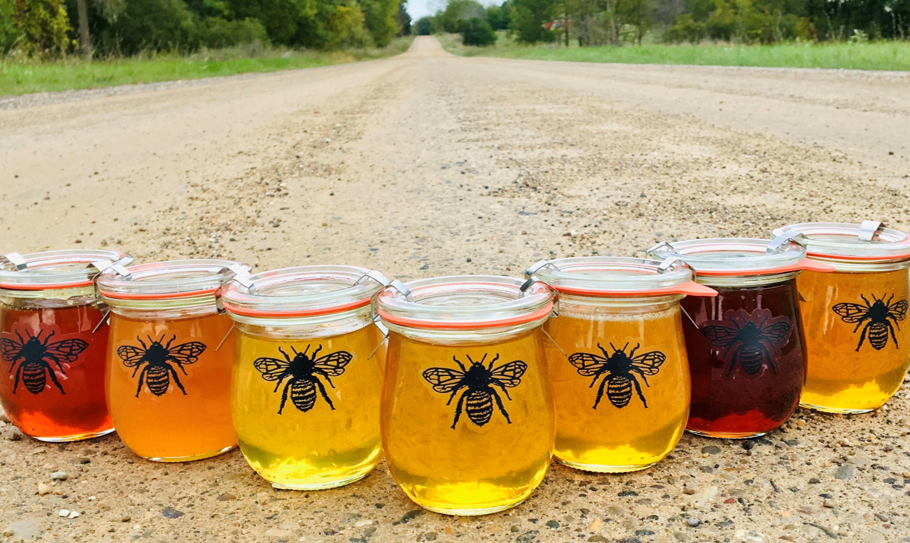
To learn more about Firefly Fields:
True Grit: The Start of the Jennings Family Farm (1979), https://firefly-fields.com/true-grit-the-start-of-jennings-family-farm-1979/
Why ‘Firefly Fields?’. https://firefly-fields.com/why-firefly-fields/
About the Farm, Virginia, and Ben, https://firefly-fields.com/our-story/